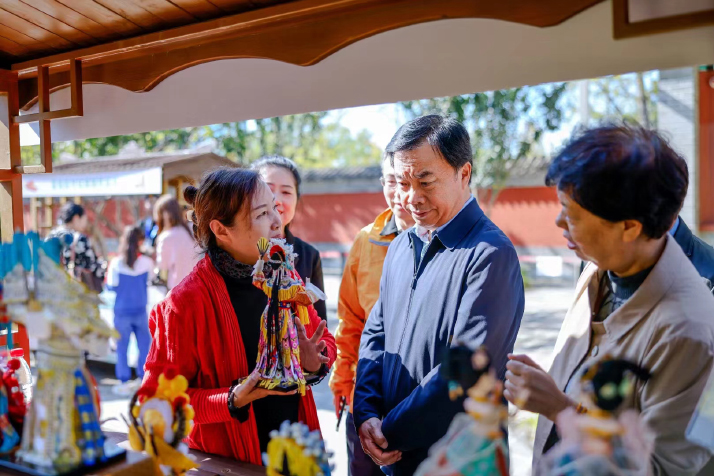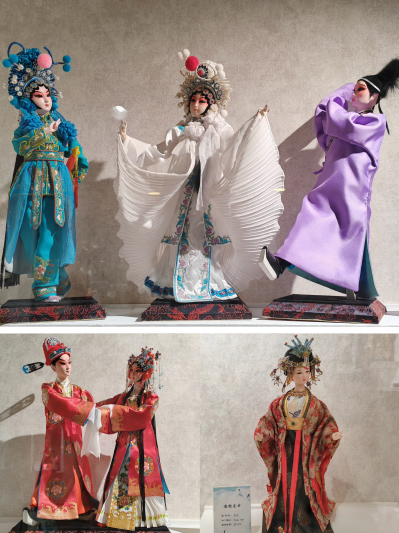| Lifestyle |
| The founding force behind China's Barbie dolls targets a broader market | |
|
|
 Tang Yan (left) introduces a Beijing silk figurine to visitors on October 22, 2023 (COURTESY PHOTO)
As computer and Internet technology blossomed across the country from the mid-1990s on, Tang Yan, an employee of an Internet company in Beijing's Zhongguancun, a major tech hub in the capital's Haidian District, gave up a promising career to save an almost lost art—that of the juanren or "Beijing silk figurine." After decades of undivided devotion to the craft, Tang now runs her own Beijing silk figurine product brand. "I fell in love with Beijing silk figurines at first sight. The elegant gestures, the smooth hair, the subtle accessories…" Tang told Beijing Review. "I had a few Barbie dolls back then and I remember telling myself: This is the Barbie of China." A big fan of dolls, Tang's studio to this day features one room exclusively dedicated to her Barbie collection, with hundreds of the American icon on display. Her admiration for the silk figurines aside, it was Barbie's global success that encouraged her to pursue her goal of saving the traditional Beijing craft from extinction. "Girls in China need their own dolls. When I was little, dolls were called yangwawa, meaning Western dolls," Tang continued. "I wanted to create dolls bearing a cultural connection to Chinese people, figurines with a rich historical connotation." And so Tang's fairytale began… What's in a name? The Beijing silk figurine is a time-honored folk handicraft in Beijing. As the name suggests, it's mainly made of silk. The figurines originated from paper or cotton puppets in the Tang Dynasty (618-907). They were inspired by historical figures and characters from classic literary works and traditional operas in ancient China, such as Mu Guiying, a pioneering female general from the Song Dynasty (960-1279), Wang Zhaojun, one of ancient China's legendary "four great beauties," and Bai Suzhen, the female protagonist in Madame White Snake, one of the most famous folktales in Chinese culture about the love between a snake maiden and a human doctor. Handmade silk figurines combine a range of intricate techniques, including carving, painting, stitching and dyeing. In 2021, the Beijing silk figurine was added to China's National Intangible Cultural Heritage List. But like the plots in many fairytales, Tang faced several obstacles on her journey from tech worker to savior of tradition. After three years of studying the art, Tang was able to create her own Beijing silk figurines and, together with five other enthusiasts, in 1997 established a dedicated studio. The party of six then spent a whole year making several figurines, only to find there was no market for their products. "A figurine could cost basically the annual salary of many people at the time," Tang said. "Many potential customers were amazed by the beauty of our products, but driven away by their price tag." Traditional Beijing silk figurines are extremely expensive because of their precious materials and complicated handicraft techniques. The completion of each figure comprises dozens of steps. The head, the face and hands of the figurines are all made of silk, and their clothes and accessories are made of silk, gauze and damask. The team's first failed attempt taught Tang that to promote silk figurines to the wider public, they would have to find ways to lower their price tag—or, in other words, to reduce their production costs. She then spent five years studying the latest technologies and conducting market research, culminating in the establishment of her own figurine brand Tang Wawa (or Tang Dolls) in 2003. Tang made creative and bold adaptions to the traditional figurines. She stopped using expensive silk and turned to cheaper materials that would maintain the dolls' classy and dainty appearance, such as wire mesh. Instead of hand painting the clothes, she used thermal transfer printers and plastic overlay machines. These measures cut the price tag to less than a tenth of the original. Tang did retain the handmade processes for hair, headgear and makeup, which she felt could not be replaced by machine technology. "The handmade techniques lend the dolls a sense of delicacy and craftsmanship, and I want to preserve these techniques to prevent the art of making Beijing silk dolls from disappearing into oblivion, which would also contradict my original goal of studying and preserving the traditional craft," she explained.  Beijing silk figurines inspired by Chinese folktale Madame White Snake (above), Peking Opera Return of the Phoenix (bottom left) and a Tang Dynasty (618-907) empress. All dolls are on display inside Tang's studio (ZHANG YAGE)
A helping hand Tang is a staunch advocate of girl power. In 2012, she collaborated with Guizhou Forerunner College in the southwestern province of Guizhou, home to all of China's 56 ethnic groups, in creating a three-year silk figurine study program there. The program specifically aims at helping young women from several ethnic groups who usually grow up with the art of embroidery and other fine handicrafts, basically all the techniques needed for making silk figurines, instilled in them from a very young age. She also teamed up with the Beijing Institute of Fashion Technology (BIFT) to provide those young women who want to further their studies with a five-year program, giving them the chance to earn a bachelor's degree, during which they study and work at Tang's studio from Monday to Friday, and spend their weekends at the BIFT learning about different fashion theories, e.g., how trends develop or how fashion moves from one stage to the next. Both programs are tuition-free and Tang provides the participants both with housing near her studio as well as financial aid to cover their living expenses. A bright future Today, the Tang Dolls are for sale across many major attractions in Beijing, including the Palace Museum, the Summer Palace, Beihai Park and the National Theater of China. Fans can also purchase the figurines from the brand's store on Alibaba's ubiquitous Taobao app. In 2023, annual sales of the Tang Dolls reached 300,000 pieces. Having made remarkable achievements in the domestic market, Tang now eyes the international market. In 2019, for instance, she hired a Thai designer and introduced a limited edition of Tang Dolls showcasing adapted Beijing silk figurine techniques and Thailand's traditional costumes. They gained popularity both at home and abroad. Tang said the most important thing to explore overseas markets is to respect local cultures and customs. Her studio, for instance, also made three versions of the Mu Guiying figurines—pink for her teenage years, red for her time as a heroic general and white for her mourning period as a widow. Chinese customers usually go for the red version, whereas international customers lean towards the white one. In ancient China, the color white was reserved for funerals and mourning periods, while red for weddings. In contemporary China, younger generations have accepted the concept of wearing white wedding dresses, but some people still deem red the most suitable color. "White stands for purity in some cultures, while Chinese people adore red for its festive and auspicious connotations. We must learn about such cultural differences before making more international products," Tang said. She plans to take her traditional Beijing silk figurines on a world tour within the next three years. "The number of artisans who can make traditional Beijing silk figurines in China is now in the single digits, so I want to do my best to save this time-honored art by introducing it to the broader market," she added. And so, Tang's fairytale continues. Copyedited by Elsbeth van Paridon Comments to zhangyage@cicgamericas.com |
|
||||||||||||||||||||||||||||||
|
